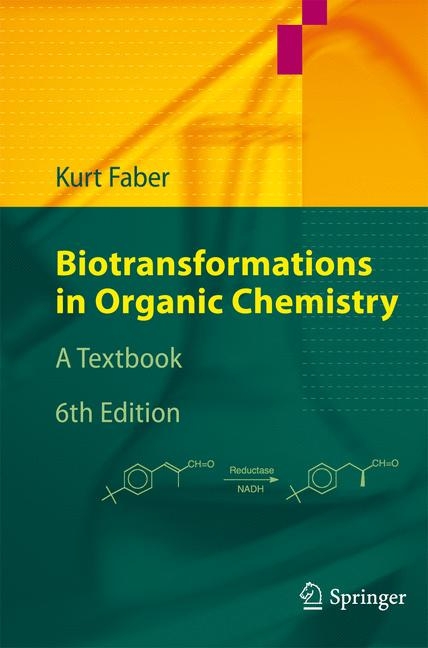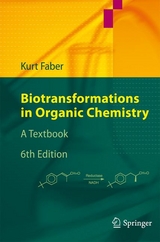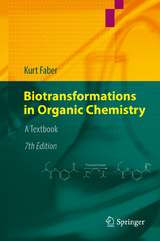Biotransformations in Organic Chemistry
Springer Berlin (Verlag)
978-3-642-17392-9 (ISBN)
- Titel erscheint in neuer Auflage
- Artikel merken
1 Introduction and Background Information1.1 Introduction..........................................................................................1.2 Common Prejudices Against Enzymes...............................................1.3 Advantages and Disadvantages of Biocatalysts..................................1.3.1 Advantages of Biocatalysts........................................................1.3.2 Disadvantages of Biocatalysts...................................................1.3.3 Isolated Enzymes Versus Whole Cell Systems.........................1.4 Enzyme Properties and Nomenclature...............................................1.4.1 Structural Biology in a Nutshell..............................1.4.2 Mechanistic Aspects of Enzyme Catalysis...........................1.4.3 Classification and Nomenclature............................................1.4.4 Coenzymes.......................................................................1.4.5 Enzyme Sources..............................................................References..... ................................................................................... 2 Biocatalytic Applications 2.1 Hydrolytic Reactions..........................................................................2.1.1 Mechanistic and Kinetic Aspects.............................................2.1.2 Hydrolysis of the Amide Bond................................................2.1.3 Ester Hydrolysis.......................................................................2.1.3.1 Esterases and Proteases.............................................2.1.3.2 Lipases.......................................................................2.1.4 Hydrolysis and Formation of Phosphate Esters......................2.1.5 Hydrolysis of Epoxides...........................................................2.1.6 Hydrolysis of Nitriles..............................................................References........................................................................................2.2 Reduction Reactions..........................................................................2.2.1 Recycling of Cofactors............................................................2.2.2 Reduction of Aldehydes and Ketones Using Isolated Enzymes...................................................................2.2.3 Reduction of Aldehydes and Ketones Using Whole Cells....2.2.4 Reduction of C=C-Bonds .......................References........................................................................................2.3 Oxidation Reactions..........................................................................2.3.1 Oxidation of Alcohols and Aldehydes...................................2.3.2 Oxygenation Reactions...........................................................2.3.2.1 Hydroxylation of Alkanes........................................2.3.2.2 Hydroxylation of Aromatic Compounds.................2.3.2.3 Epoxidation of Alkenes............................................2.3.2.4 Sulfoxidation Reactions............................................2.3.2.5 Baeyer-Villiger Reactions.........................................2.3.2.6 Formation of Peroxides.............................................2.3.2.7 Dihydroxylation of Aromatic Compounds...............2.3.3 Peroxidation Reactions............................................................References.... ...................................................................................2.4 Formation of Carbon-Carbon Bonds.................................................2.4.1 Aldol Reactions.......................................................................2.4.2 Thiamine-Dependent Acyloin- and Benzoin Reactions.........2.4.3 Michael-Type Additions.........................................................References........................................................................................2.5 Addition and Elimination Reactions.................................................2.5.1 Cyanohydrin Formation..........................................................2.5.2 Addition of Water...........................................2.5.3 Addition of Ammonia...........................................References........................................................................................2.6 Transfer Reactions.............................................................2.6.1 Glycosyl Transfer Transferases..............................................2.6.1.1 Glycosyl Transferases........................................2.6.1.2 Glycosidases........................................2.6.2 Amino Transfer Reactions...................................................References........................................................................................2.7 Halogenation and Dehalogenation Reactions...................................2.7.1 Halogenation...........................................................................2.7.2 Dehalogenation.......................................................................References....................................................................................... 3 Special Techniques 3.1 Enzymes in Organic Solvents..........................................................3.1.1 Ester Synthesis........................................................................3.1.2 Lactone Synthesis...................................................................3.1.3 Amide Synthesis.....................................................................3.1.4 Peptide Synthesis....................................................................3.1.5 Peracid Synthesis....................................................................3.1.6 Redox Reactions.....................................................................3.1.7 Medium Engineering...............................................................3.2 Immobilization..................................................................................3.3 Artificial and Modified Enzymes.....................................................3.3.1 Artificial Enzyme Mimics.....................................................3.3.2 Modified Enzymes..........................................................3.3.2.1 Chemically Modified Enzymes................................3.3.2.2 Genetically Modified Enzymes................................3.3.3 Catalytic Antibodies................................................................References........................................................................................ 4 State of the Art and Outlook................................................................. 5 Appendix 5.1 Basic Rules for Handling Biocatalysts..............................................5.2 Abbreviations....................................................................................5.3 Suppliers of Enzymes.......................................................................5.4 Commonly Used Enzyme Preparations...........................................5.5 Major Culture Collections................................................................5.6 Pathogenic Bacteria and Fungi........................................................
| Zusatzinfo | XI, 423 p. 347 illus., 335 illus. in color. |
|---|---|
| Verlagsort | Berlin |
| Sprache | englisch |
| Maße | 155 x 235 mm |
| Gewicht | 760 g |
| Themenwelt | Naturwissenschaften ► Chemie ► Organische Chemie |
| Schlagworte | Biocatalysis • Biotechnology • Biotransformation • enzymes • Organic Chemistry • Organische Chemie • Organische Synthese • Whole Cells |
| ISBN-10 | 3-642-17392-6 / 3642173926 |
| ISBN-13 | 978-3-642-17392-9 / 9783642173929 |
| Zustand | Neuware |
| Informationen gemäß Produktsicherheitsverordnung (GPSR) | |
| Haben Sie eine Frage zum Produkt? |
aus dem Bereich





